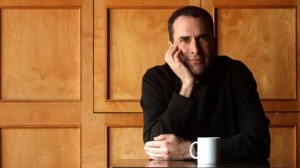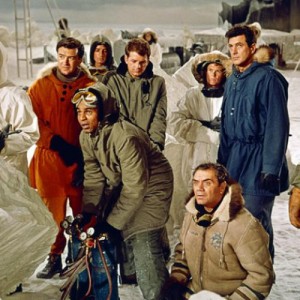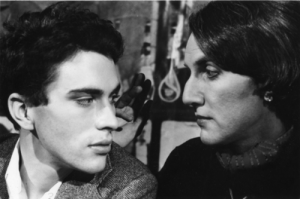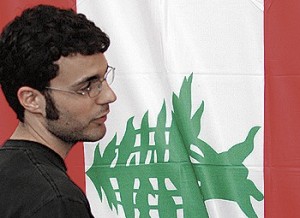Audio Visual Judo
“Boy wonder” is the name Stephen gives him, John Greyson’s laconically hedonistic, painter genius boyfriend. I would like to find the uncaped crusader in a state of terminal distraction, or better, slumped over his desk asleep in the midst of his overflowing in-tray and daily commitments. Stepping over the tidy piles I would lean up close and whisper a single word into his waiting ears: relax. It is a word notably absent from the Greyson lexicon of self description. As his friend and former partner-in-crime Gary Kibbins once remarked, “John could stay up all night dancing, and then kiss his alarm clock hello at dawn and resume pounding out his new script. He played hard, he worked hard.”
Turning play into work and work into play has made John at once an unstoppable force and immovable object. How to account for this restlessly driven, it’s never enough, work ethic horizon? Leaving aside the too evident flight from his own mortality, John is one of those who takes the news personally. Instead of settling back into the consumerist expertism fostered by headline breakers left and right, he hears each recounting of injustice (happiness is never news) as a personal call to action.
To offer each example of his hot line responses would amount to a full recounting of his art and life, nearly every movie and performance has arrived as a reaction shot to a social justice movement or ethical breach requiring urgent attention — whether it is the delivery of generically produced AIDS medicines to South Africa, the necessity of copyright violation, or the support of the Boycott, Divestment and Sanction Campaign against the apartheid Israeli state. In his hands, personal projections have become a moral arbiter, as he adds his voice to those already present in the public square of the mediascape, Instead of a heroic and painterly mark that stains the blank furrow of a canvas, he enters a scene that is already underway, like his recent suite of shorts that musically engage performers like Elton John and Justin Bieber via remixes of their own tunes, urging them not to ply their trade in Israel. He is never “at the beginning,” his ambitions rest neither with the first word nor hopes for the last, instead, he finds himself always in the midst of a social web of produced and producing identities. His work takes sides, quickly identifying and then separating good from bad, the powerful and the powerless, before complicating that division with an audio-visual conscience that lays its concern down with a light touch.
As an artist whose entry point admits him to a conversation already underway, it is little surprise that he receives and adapts established modes of address. His borrowings might also be understood as a way of listening. How did Derrida define ethics? To be able to speak to the other in their own language. Perhaps even to listen. There is an echo of this speaking and hearing in the protean forms that John’s work has unwrapped over the past three decades. If his ironic, Brecht-inspired hyperstylings favour bas couture tableau, it is not at the expense of verité uncoverings. Because in John’s hands, being avant garde means having someone else’s cake and eating it too. Even in some of his earliest eyebrow raisers, he favoured a hybrid collage style that married a variety show of popular forms. Part of the joy ride of Moscow Does Not Believe in Queers (27 minutes 1986) is the way it mashes together documentary footage, staged dramatic dialogues and a found footage collage relating newly outed AIDS poster boy Rock Hudson in a submarine journey to Russia. The Pink Pimpernel (32 minutes 1989) offers a similar formal promiscuity, and allows no less than four different safe sex adverts to redirect proceedings. John’s movies might be described as audio visual judo—using the dominant cinematic forms to work ‘against’ themselves, or at least, against the tired messages of power that genre momentums so often re-enact.
He copped this lesson from once romantic partner and video dad Colin Campbell. Colin’s refashioned home movies transformed whatever was at hand and pressed it into the service of that day’s shooting. If John has uncovered the alchemical secret of turning play into work, it was Colin who showed him how to turn making movies into something fun. Let’s just shoot this one take and then we’ll have another martini, shall we? In a set of stunning set pieces, most of which John appeared in (despite his best efforts to the contrary), from Modern Love (1978) to White Money (1983), Colin demonstrated the virtues of thrift store aesthetics, minimal sets used to maximum advantage, and casting calls made to friends in order to project a mix of today’s headlines and last night’s gossip.
The first and best student of The Women from Malibu’s Video Art Academy and Finishing School took his lessons seriously, even as he continued to refine his own pastiche aesthetic at a blistering pace. He pursued screen dreams that took him from one-person video art briefs to a run of seven features beginning with Urinal in 1998. A stint at the Canadian Film Centre had bigged up his production chops and soon found him alternating between award winning short studies, feature length work and occasional TV episodics. But the pressures of industrial picture making proved wearing, its professional hierarchies far from the consensus politics that continued to mobilize his activist callings. So in September 2004 he began teaching film production at Toronto’s York University, though it wasn’t until the next year that he was hired full time. It would be the first permanent job he would hold in 15 years.
In an article entitled ‘York’s Middle East War,’ Toronto Life writer Brett Grainger writes, “Even Torontonians who have never visited the city’s ‘other university’ know its reputation: ugly architecture (the raw brutalist style of the Ross Building led students to dub it ‘the Kremlin’), low academic standards (‘If you can hold a fork,’ the saying goes, ‘you can go to York’), remote northern location (it’s so far from anything, it has its own shopping mall… In the popular imagination, York is a Communist Shangri-La run by bearded, tenured radicals, Trotskyist unions and window-smashing hooligans.” (Toronto Life, Feb. 5, 2011)
One of the hot button issues in the university has been the ongoing mistreatment of Palestinians by the Israeli state. Smartly organized demos by Palestinian students were almost invariably met by well organized Zionist lobbies working on and off campus; they are the machine in the ghost that works to stifle criticism of Israel wherever it might appear. Criticism equals anti-Semitism, and must be shouted down, decried, threatened, and stifled by any means necessary. Hate mail campaigns, death threats, public defamations via national newspapers, plundered email and social network accounts, harassed relatives—it’s all part of the code, at least in Toronto, which remains a bastion of pro-Israeli extremism. Though Toronto is also the city that initiated the first Israeli Apartheid Week (by the Arab Students Collective at the University of Toronto) in 2005, an event that is slowly but surely spreading across the globe, even in countries like Israel.
An escalating fever of demos and counter demos awaited the new York University President Lorna Marsden when she took office in 1997, not long after the longest teacher’s strike in Canadian history. Her ten year stint included elaborate corporate tangos, whopping private sector investments and a steady intolerance for the public expression of students’ political views. In January 2005, during a protest against George Bush’s second inauguration, she summoned the police on campus who predictably lay a beating on the student assembly, sending one unfortunate to hospital. This prompted Greyson’s second Megaphone Choir demo, entitled Motet for Free Speech, on January 27, 2005. But her most public stifling of expression, and the action by which she will remain forever captioned, was the expulsion of Dan Freeman-Maloy for the use of an “unauthorized sound amplification device.”
Freeman-Maloy was involved in two demos unloved by the administration, the first was held on October 22, 2003, or “Israel Defense Forces (IDF) Appreciation Day” (I’m not making this up) as it is known on campus. The culminating celebration of the day was led by the mayor of an illegal Israeli settlement, and Freeman-Maloy showed up with a megaphone to leverage the signal to noise ratio. The second demo on March 16 was a commemoration of the death of US peace activist Rachel Corrie. Corrie had knelt in front of the home of Palestinian pharmacist Samir Nasrallah in the Gaza Strip to keep it from being bulldozed. A fellow International Solidarity Member shouted into a megaphone at the bulldozer driver that Corrie was being pulled underneath the vehicle, but these warnings were ignored or unheard as she was crushed to death. In her York University memorial a year later, “approximately 30 of us set up a mock check-point, some dressed as soldiers and some as civilians, a crowd of some 150 militant Zionists that had been congregating nearby in preparation proceeded to rush our display. We had postponed our action for a period to avoid a clash, but were unsuccessful. We were surrounded, and for nearly an hour faced physical and verbal intimidation. President Marsden is contending that this somehow ‘contributed to the threat of harm to the safety and well-being of York University community members.’” (My Expulsion from York University: an appeal for support and reconsideration by Daniel Freeman-Maloy, May 3, 2004)
Freeman-Maloy’s expulsion was widely decried, not least because university protocol requires that students be addressed by a disciplinary committee. If some voices are more equal than others, there remains a procedure which allows feedback from both sides because the university has not yet been declared a kingdom. In this instance, however, Marsden acted unilaterally, and dispatched the student via executive fiat. The university’s senate passed a motion urging her to rescind the ban, while students and professors alike penned dissenting views.
Freeman-Maloy received his letter of expulsion on April 30, 2004, and three weeks later John Greyson responded with a musical action he named Megaphone for Amplified Voices, inviting a roomful of activists to sound off into megaphones. They can’t arrest us all, can they? Conducted by the musically intrepid David Wall, a calm intensity radiated from the group of protest familiars, as each held a black, homemade paper megaphone that wouldn’t have looked out of place on the head of Dada preacher Hugo Ball. Everyone sung a fave quotation (headline, aphorism) in a single note, the chorus rising in the university’s Vari Hall to a pleasing, post-harmonious pitch.
The Hall is a well known site at the university, as its architects Moiyama and Teshiya write, it was built “to give the sprawling suburban campus a sense of urban order… it serves as a functional and symbolic ‘front door.'” (www.mtarch.com/mtavari.html) President Marsden’s expulsion was surely designed to restore this sense of order, just as Greyson’s performance ensemble was intended to disrupt it. Two different pictures of the front door are being produced, and the second usefully reminds us that every opening is also a closing, that every door, no matter how broad seeming, comes with an unwelcome mat.
From this afternoon assembly, John constructed a powerful five minute protest video named after the performance. (It’s going to be fun, he assured me (though fun is a word he uses interchangeably with all night work sessions) because he was going to use the opportunity to learn the edit software. Cutting the screen into three fields, he streamed a series of texts that tell the story of Freeman-Maloy’s expulsion and registers the answering lies of the university’s camouflage attempts. In a gesture familiar from his earlier mix tapes, he blends live performance footage with newsreel clips showing Palestinians digging out of the rubble left by the latest round of Israeli attacks. The familiar maxim of thinking locally and acting globally arises easily out of the collage, as a flurry of sung quotations, now given shape as streaming text, float across the three screens, offering reflections on tyranny by Hannah Arendt, Edward Said, Hussam Mustafa and more. My neighbourhood, my library, my world.
One of the many notables about this agit-prop miniature, is that John took it on shortly after he had handed back his director’s whistle for occasional episodic TV adventures (“I felt like an imposter”), and had only recently begun to teach at York, heady stuff for someone that never quite managed to finish high school. Not only did John lack the personal force field of tenure to shield him from any potential blowback from the administration he was critiquing, he only held a temporary position at the university and was still in the midst of applying for a permanent one. Because this personal stake might have occluded the issue at hand, it was never addressed in the tape, but instead worked off-screen to give the work some of its rewarding tension.
“… it is not as if ‘I can say I’m free and then my performative utterance makes me free.’ No. But to make the demand on freedom is already to begin its exercise and then to ask for its legitimation is to also announce the gap between its exercise and its realization and to put both into public discourse in a way so that that gap is seen, so that that gap can mobilize.” (Who Sings the Nation State by Judith Butler and Gayatri Chakravorty Spivak pp. 64-65, London: Seagull Books, 2007)
When Judith Butler speaks about the performance act lying in the gap between what we want and what we don’t have, I think she’s also describing the necessary condition for creating a picture. Something is missing, and across this gap, this absence, something is constructed as a kind of temporary bridge. It doesn’t fill the hole, it doesn’t relieve the problem by itself. The presence of 50 megaphone-holding singers at the university didn’t bring the administration down, or reverse the expulsion of Dan Freeman-Maloy, or redraft official freedom of speech policies at the university. Instead, it created a picture of what freedom of speech appears like. Sounds like even. It is a forward looking, even utopian gesture, but at the same time, because it is grounded in a real situation, it points back at the university’s dean and the expulsion. A picture, like a bridge, is often pointed in two directions, backwards and forwards, occupying this necessary and temporary interstitial space, a space between two spaces, between two landings or cities or states. Between Palestine and Toronto, for instance. A real picture, unlike the litter of false positives that crowd the airwaves, is a place of dynamic movement, even if it occupies only a single frame. It carries us over, it bears us across, but at the same time it returns us. It’s a reminder, a mark left behind. A wish with pixels attached.
In what was regarded by some as a litmus test for academic freedom, Freeman-Maloy sued President Marsden for public misfeasance, libel and breach of academic freedom. After a protracted series of court cases, he won the right to sue her, and an out of court settlement was reached just as Marsden was about to end her term as president, and Freeman-Maloy was set to finish his undergraduate work at the university. “’So she is leaving and he is staying,’ he (“Peter Rosenthal, Mr. Freeman-Maloy’s lawyer) said, referring to the coming departure of Dr. Marsden. Mr. Rosenthal said the timing of the deal was not linked to his client’s approaching graduation or the end of Dr. Marsden’s tenure as head of the university.” (“York Settles with student who was banned over protest, by Elizabeth Church, Globe and Mail, May 8, 2009) Really truly? If the whole sorry episode were made into a movie, complete with judge’s gavels, they wouldn’t write it like this, it would be too tidy by half. Too much like a movie. There are times, it seems, when life insists on imitating art. Oh, did I mention? John got his tenure. And even though he never quite got around to finishing high school back in the day before they said back in the day, he’s just breezed through a master’s degree and is now on course to pick up a PhD—just for fun, the boy wonder insists, with an airy wave of dismissal. The machine of fun, the audio visual conscience, the found footage judo continues.
Introduction (April 1, 2012 TIFF Lightbox)
This introduction to a program of John Greyson’s short works was delivered by Janine Marchessault and Mike Hoolboom as part of the 10-screening retrospective at the TIFF Lightbox, held in conjunction with Vtape’s release of an 8-DVD box set of John’s work)
Mike: If newspapers weren’t owned by corporations, perhaps they would start to look like the movies of John Greyson.
Janine: Newspaper headlines were the beginning of so many scripts.
Mike: In other words, for John, looking is a verb, an action.
Janine: Looking doesn’t create distance, it produces intimacy.
Mike: And the intimacy, the close contact, quickly promotes different points of view, different approaches even.
Janine: Like in tonight’s closing note, Rex vs Singh, where he collaborates with pals Ali Kazimi and Richard Fung to produce a foursided view of a pair of Sikh millworkers accused of sodomy in 1915 Vancouver
Mike: John has presided over some curious marriages.
Janine: Kurt Weill and hockey night in Canada.
Mike: Elton John and Gaza.
Janine: The Group of Seven and the G8 summit.
Mike: Politics makes strange bed bugs.
Janine: He keeps returning to artists, to the sense that artists and their work matter,
Mike: Art changes the conversation.
Janine: What’s on tonight’s sched?
Mike: Globalization, Israeli apartheid, gay bashing, legalized homophobia.
Janine: If we weren’t so busy singing along we’d be downhearted at the prospect.
Mike: How does he do it?
Janine: Well, like every truly original artist, he can’t help borrowing from others.
Mike: Could he be Canada’s greatest director of musicals?
Janine: Kurt Weill returns as a queer Canadian media activist. Well, why not?
Mike: Not content with being good looking, he wanted to make good looking movies.
Janine: And now he’s working on two new features.
Mike: Sometimes less isn’t more. Sometimes only more is more.
Janine: It’s hard to forgive him for making me feel so lazy, but I forgive him.
Mike: We forgive you John, for making us all feel lazy.
Janine: For not feeling the urgency that comes when death keeps whispering into your ear.
Mike: It won’t be long now.
Janine: How much time do any of us have really?
Mike: It won’t be long now.
Janine: But in this brief moment before we go, let there be a flourish of light, a bouquet of pictures.
Mike: A song.
Janine: And the song says yes.
Mike: And the song says Thank you John.
Janine: Thank you John.
G7 vs. G8 (2009), Group of Seven use paint against the G8 summit
Hey Elton (2010), Elton is asked to join boycott and cancel Tel Aviv concert
The Making of Monsters (1991), Brecht directs a musical about the gay murder of a school teacher in a Toronto park by five teens; winner of Best Short Canadian Film, TIFF; Best Short Gay Teddy, Berlin International Film Festival
Rex Vs. Singh (2008), a collaboration with Ali Kazimi and Richard Fung. Four stagings of the trial of two Sikh millworkers accused of sodomy in 1915 Vancouver.








